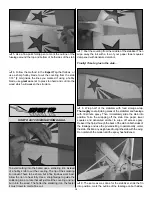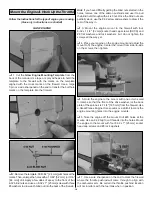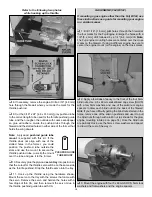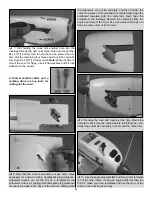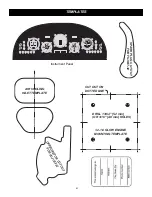
If you haven’t done so, mount the spinner using the
appropriate adapters as described on page 5. At this stage
the model should be in ready-to-fly condition with all of the
systems in place including the engine, cowl, propeller,
spinner and all components of the radio system.
❏
1. If using a Great Planes C.G. Machine, set the rulers to
5-1/4" [133 mm]. Mount the wing to the fuselage and
proceed to the next step. If not using a C.G. Machine, use a
fine-point felt-tip pen to accurately mark the C.G. on the top
of the wing 5-1/4" [133 mm] back from the flat part of leading
edge at the middle. Lay a piece of narrow (1/8" [2 mm]) tape
over the line so you will be able to feel it with your fingers
when lifting the model to check the C.G.
❏
2. With the wing attached to the fuselage, all parts of the
model installed (ready to fly) and an empty fuel tank, place
the model upside-down on the CG Machine or lift it upside-
down at the balance point you marked.
❏
3. If the tail drops, the model is “tail heavy” and weight
must be added to the nose to balance. If the nose drops, the
model is “nose heavy” and weight must be added to the tail
to balance. If possible, relocate the battery pack and
receiver to minimize or eliminate any additional ballast
required. If additional weight is still required and you are
using a glow engine, nose weight may be easily added by
using a “spinner weight” (GPMQ4645 for the 1 oz. [28g]
weight, or GPMQ4646 for the 2 oz. [57g] weight). If spinner
weight cannot be used or is not enough, use Great Planes
(GPMQ4485) “stick on” lead. To find out how much weight is
needed, begin by placing incrementally increasing amounts
of weight on the fuselage where needed until the model
balances. Once you have determined the amount of weight
required, it can be permanently attached. A good place to
add stick-on nose weight is to the firewall or inside the fuel
tank compartment as close to the firewall as possible.
Note: If attaching weight to the firewall, do not rely upon the
adhesive on the back of the lead weight to permanently hold
it in place. Over time, fuel and exhaust residue may soften
the adhesive and cause the weight to fall off. Use #2 sheet
metal screws, RTV silicone or epoxy to permanently hold the
weight in place.
❏
4. IMPORTANT: If you found it necessary to add any weight,
recheck the C.G. after the weight has been installed.
❏
1. Turn the model upright and set it on your workbench.
With the wing level, have an assistant help you lift the model
by the engine propeller shaft and the bottom of the fuselage
under the trailing edge of the fin. Do this several times.
❏
2. If one wing always drops when you lift the model, it
means that side is heavy. Balance the airplane by adding
weight to the other wing tip-it may be stuck directly to the
covering or permanently glued inside the wing. An airplane
that has been laterally balanced will track better in
loops and other maneuvers.
Balance the Model Laterally
5-1/4” [133 mm]
This is where your model should balance for the first flights.
Later, you may wish to experiment by shifting the C.G. up to
1" [25 mm] forward or 1" [25 mm] back to change the flying
characteristics. Moving the C.G. forward may improve the
smoothness and stability, but the model will then be less
aerobatic and may require more speed for takeoff and
make it more difficult to slow for landing. Moving the C.G. aft
makes the model more maneuverable, but could also cause
it to become too difficult to control. In any case, start at the
recommended balance point and do not at any time
balance the model outside the specified range.
More than any other factor, the C.G. (balance point) can
have the greatest effect on how a model flies, and may
determine whether or not your first flight will be successful.
If you value this model and wish to enjoy it for many flights,
DO NOT OVERLOOK THIS IMPORTANT PROCEDURE.
A model that is not properly balanced will be unstable and
possibly unflyable.
Balance the Model (C.G.)
25
Summary of Contents for Giant Super Sportster
Page 32: ......


